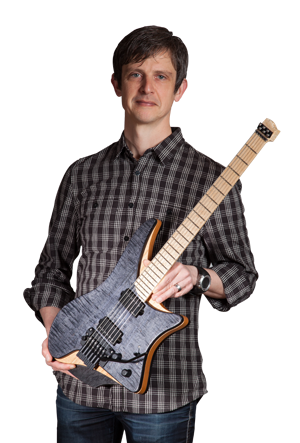Most EGS guitar orders are for stainless frets, which, if you’ve ever worked with them, take a lot of effort to work with. Accurate seating of the frets makes for less leveling work, which in turns leads to less re-crowning work and saves lots of time. I have always hammered my frets in, which doesn’t always meet the above criteria, so I wanted to try pressing in the frets. Conventional presses (read Stewart-MacDonald) come with brass inserts for set radii. But with a compound radius fingerboard, or a multiscale fingerboard, there is a lot of variation of the radii across the fretboard. Additionally, the StewMac inserts are only 63.5 mm (2 1/2″) with isn’t enough for even a 7-string multiscale fingerboard. After a lot of experimenting, I have come up with a preferred compound radius formula starting with 16″ at the zero fret and reaching 20″ at the 24th fret. For a 25.75″-25″ scale on a 7-string with a neutral 4th fret, the following picture shows the radius that each fret describes: As you can see, the increase in radius between each fret is not linear, but less at the first frets and the last frets, due to the angles of the frets. The idea of making the press...
Learn MoreCheck out these new downloads: EGS Fixed Bridge Brochure EGS Pro Tremolo Brochure EGS Guitar Brochure Inside EGS Guitar Brochure...
Learn MoreHere follow some instructions on how to get started with your very own EGS build. Feel free to e-mail further questions, and I will try to add to this guide and keep it up-to-date. Build your own EGS guitar Planning First of all, e-mail guitarworks@thestrandbergs.com and ask for permission. The materials on the site are licensed under Creative Commons. You may use them under two conditions: that you ask permission first and that you make your own enhancements public also under the same Creative Commons license. The body shape Start by downloading the body shape outline. Print it out in scale 1:1 and transfer to a paper large enough to hold your complete guitar, including the neck and any headstock you are considering. Mark a center line and, along this, mark the location of the saddles, the 12th fret and the nut. The body shape outline that you downloaded needs to be adjusted in the neck pocket region and possibly in the bridge region, so it is critical that you do this on some cheap media (i.e. paper or your computer) before starting to shape wood. In the bridge region, you need to leave sufficient material to mount the base plate while leaving room for your fingers to tune....
Learn MoreMany players have contacted me and been curious about how the EGS guitars sound with “normal” pickups. Johan Lundgren of Lundgren Guitar Pickups kindly lent me a pair of Heaven ’57 humbuckers for a test. Getting this done was not as straight-forward as I had hoped. The Alumitones are a few millimeters smaller (36 x 65 mm) than a regular humbucker (38 x 68 mm), and for aesthetical purposes I had cut the pickup cavities as close to the original Alumitones as possible. This meant that I actually had to get the router out to enlarge the holes for the test. Another interesting fact is that the two Lundgren pickups weigh 250 grams and the two Lace pickups weigh 90 grams. With the EGS#1 guitar weighing in at about 2kg, it still results in a fairly light instrument, but the increase in weight is quite large percentage-wise. You will have to judge the results for yourself. The larger frequency response of the Lace pickups allow them to be equalized into any type of sound using tone controls and effects, but the clips are recorded with the same settings on the amp. Some comments from Jonas – his personal views and reflections: The Alumitones have a “sparkle” on the high...
Learn MoreI rigged the neck and routed a channel for the string locks last weekend already, but didn’t have time to post the pictures. I used an old pickup router template. I created a drilling template since I did not have access to the milling machine that I usually do and hence had to cut the holes manually. The larger holes are for the guiding pins and the smaller to hold the screws. Ideally, you would keep the neck square in section where the string locks sit, to give room for the full length of the screws. In this case, the neck is round and I have to cut the outer screws quite...
Learn MoreAnodized aluminium is not very conductive to electricity, which can lead to string grounding issues. It is quite easy to overcome though, and with recent and future orders, I am including the necessary materials. However, I do not want to make any assumptions on how you would prefer it to work, so I am not grinding off the anodization as described below. Step 1 – route the ground cable Drill a hole into the control cavity as usual and run a bare wire through it to the bridge. Step 2 – grind off anodization Next, grind off the anodization (using a Dremel for instance) from underneath the base plate. As well as on top of the base plate. Take care to check an approximate intonation first though. You want to make sure that the area you grind off will be completely covered by the bridge when it is mounted. The ground off portion should sit straight under the saddle. Step 3 – re-mount with the spring Lastly, insert the supplied spring into the bridge and re-mount it. The saddle will have full contact with the ground off anodization through the spring, and on to the ground wire that sits under the bridge...
Learn More


